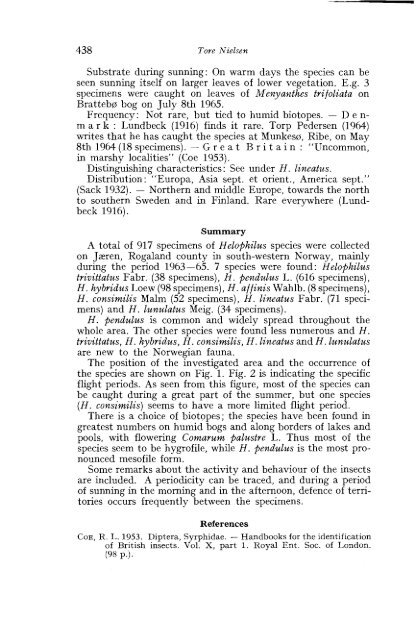Full-text - Norsk entomologisk forening
Full-text - Norsk entomologisk forening
Full-text - Norsk entomologisk forening
You also want an ePaper? Increase the reach of your titles
YUMPU automatically turns print PDFs into web optimized ePapers that Google loves.
438 Tore NielsenSubstrate during sunning: On warm days the species can beseen sunning itself on larger leaves of lower vegetation. E.g. 3specimens were caught on leaves of Menyanthes trifoliata onBratteb~ bog on July 8th 1965.Frequency: Not rare, but tied to humid biotopes. - D e n-m a r k : Lundbeck (1916) finds it rare. Torp Pedersen (1964)writes that he has caught the species at Munkesg, Ribe, on May8th 1964 (18 specimens). - G r e a t B r i t a i n : "Uncommon,in marshy localities" (Coe 1953).Distinguishing characteristics: See under H. lineatus.Distribution: "Europa, Asia sept. et orient., America sept."(Sack 1932). - Northern and middle Europe, towards the northto southern Sweden and in Finland. Rare everywhere (Lundbeck1916).SummaryA total of 917 specimens of Helophilus species were collectedon Jzren, Rogaland county in south-western Norway, mainlyduring the period 1963-65. 7 species were found: Helophilustrivittatus Fabr. (38 specimens), h. pendulus I,. (616 specimens),H. hybridus Loew (98 specimens), H. affinis Wahlb. (8 specimens),H. consimilis Malm (52 specimens), H. lineatus Fabr. (71 specimens)and H. lunulatus Meig. (34 specimens).H. pendulus is common and widely spread throughout thewhole area. The other species were found less numerous and H.trivittatus, H. hybridus, H. consimilis, H. lineatus and H. lunulatusare new to the Norwegian fauna.The position of the investigated area and the occurrence ofthe species are shown on Fig. 1. Fig. 2 is indicating the specificflight periods. As seen from this figure, most of the species canbe caught during a great part of the summer, but one species(H. consimilis) seems to have a more limited flight period.There is a choice of biotopes; the species have been found ingreatest numbers on humid bogs and along borders of lakes andpools, with flowering Comarum palustre L. Thus most of thespecies seem to be hygrofile, while H. pendulus is the most pronouncedmesofjle form.Some remarks about the activity and behaviour of the insectsare included. A periodicity can be traced, and during a periodof sunning in the morning and in the afternoon, defence of territoriesoccurs frequently between the specimens.ReferencesCOE, R. L. 1953. Diptera, Syrphidae. - Handbooks for the identificationof British insects. Val. X, part 1. Royal Ent. Soc. of London.(98 P.).
















